My third project for Applied Ethnobotany is a research project about wild plants within Alaska’s food system. This blog post is an adaptation of my final paper for an introductory food systems class in the Prescott College Master’s in Sustainable Food Systems program, available here for feedback.
Land Acknowledgement
I live in Homer, Alaska, on the ancestral and unceded territory of the Dena’ina. Homer is on the edge of what is now called the Kenai Peninsula, which gets its name from the Kahtnuht’ana, the Kenai River People. They are federally recognized as the Kenaitze Indian Tribe. All land in Alaska is Indigenous land, so keep that in mind as I talk about land and resource management in Alaska. Any research and regulation on personal use harvesting must be done in collaboration with Indigenous groups (International Society of Ethnobiology, 2006).
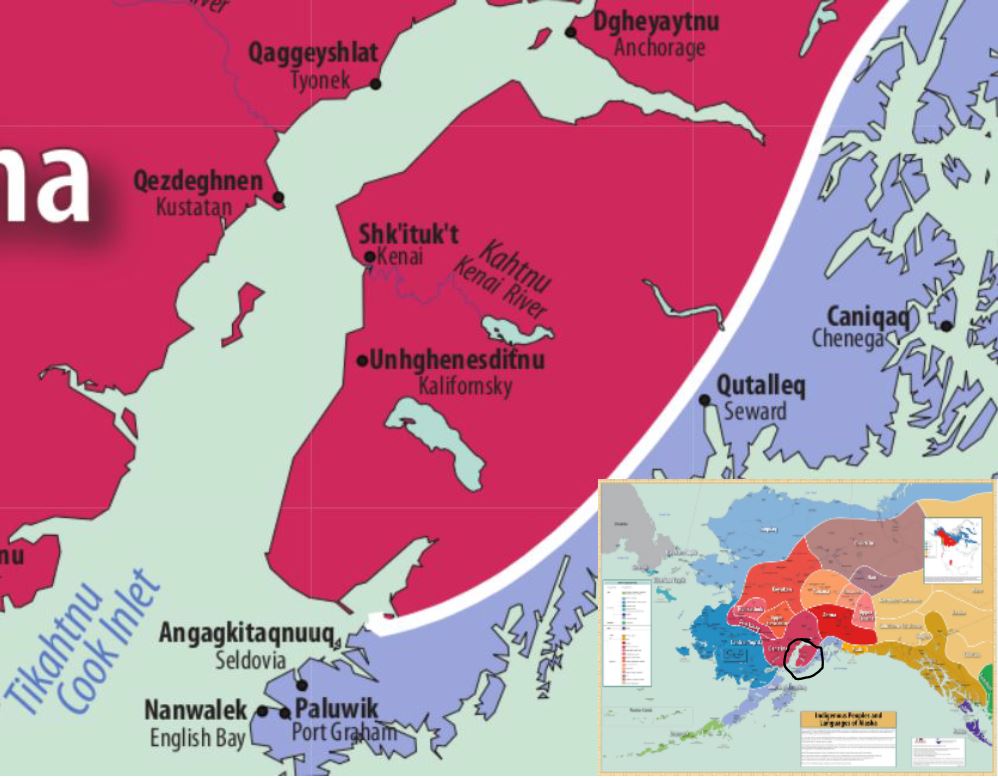

Cloudberries:
But first a little botanical information about one of the berries pictured above.
Rubus chamaemorus L. (Rosaceae family)
Aqpik/Aqpiik/Aqpiich (Inupiaq) (Jones, 2010, p. 81)
Nqutl’/Nqitl’/Nqitł’/Nqutł/Enqutł’ (Dena’ina Qenaga) (Smyth, n.d.)
Cloudberry (the English name in urban Alaska), salmonberry (what it’s called in English in Alaskan villages), baked appleberry (not a name I’m familiar with but it does give an excellent description of the flavor/consistency)

You can see the circumpolar distribution. Cloudberry plants are dioecious, meaning the flowers are unisexual, with male and female flowers on separate plants. This is unusual in the Rosaceae family where most plants are monoecious. The plants spread via rhizomes, which means that often a large patch is all clones from the same (male or female) plant. Each plant has one flower. The male flowers have stamens with yellow pollen and the female flowers have white styles and some white sterile stamens (Rubus chamaemorus (Cloudberry), n.d.). This is all new information to me and I will certainly try to check out some cloudberry patches and their flowers this summer. Flowers in the rose family typically have 5 petals and 5 sepals. I read that there is some variation in cloudberry flowers (from 4 to 8 petals) (Rubus chamaemorus (Cloudberry), n.d.; Jones, 2010). The plant has the stipules at the base of the leaves that are characteristic of the rose family. The leaves are opposite with palmate venation, toothed margins, and only a few per plant. The plants grow low to the ground, 2-8 inches tall.


The fruit is an aggregate (like a raspberry but with larger seeds), and each tiny part is called a drupelet (like a miniature stone fruit). Each fruit can have from 1 to 18 drupelets. The fruit is reddish and hard at first, then as it ripens, it turns brilliant orange and yellow. As you pick, you can feel this, with the red berries holding fast to the stem and the orange ones releasing easily. They get much softer as they ripen. The first time I picked them, my friend told me they were her favorite and they taste like cherries with the consistency of applesauce. Anore Jones says they taste like oranges and apricots. Jones writes that of all the berries, aqpiich are most prized because “they are the first to ripen, they are large, sweet, and easy to pick, and they keep very well” (p. 82). Those are all very important qualities when making dietary choices in the Arctic.
Jones writes that “as an aqpik changes through the summer, its Iñupiaq name changes” (p. 86). So there are different words for: “flower”, “it is drying up”, “it has closed”, “big cover” when inside a berry is growing, “hard”, “just opening” as the sepals open to uncover the ripening fruit, “really ripe”, “past ripe, but still good” (p. 86). This attention to the plant’s development also highlights its cultural importance.
In the Native American Ethnobotany Database, there are 33 matches (Rubus chamaemorus, n.d.). The fruit is eaten fresh or stored for winter, and tea of roots and stems can be used medicinally for reproductive health.
I would like to find more research about this important plant. I read a few things in my research that made me wonder if this is a particularly vulnerable species, but I didn’t find enough information to really get into it here. With male and female plants growing separately, and potentially flowering at different times, and pollinators being absolutely necessary, there are a lot of variables that may be influenced by climate change and habitat disturbance. Also with the great variability in fruit size and shape (1-18 drupelets), I wonder what causes the variation and if the pollinators have anything to do with it.
Project 3:
We are at a pivotal point regarding climate change and decreasing global biodiversity. Nationwide, more people than ever are recreating on public lands and harvesting plants and fungi for food and medicine. Foragers are in a position to observe, collect, and share an immense amount of place-based knowledge when provided the support to do so.
Wild-harvested plants are both culturally and nutritionally important in Alaska. They are frequently harvested, gifted, and traded, so data on harvest quantities and locations are often incomplete, informal, and excluded from economic reports. There is a gap in research around the non-commercial harvest of wild plants. Often, people are turning to social media to bridge the knowledge gap. In future research, I will examine how plant knowledge spreads through these networks and how they can be used to monitor and improve ecosystem and community health.
Imagine that you hold a berry, perhaps a cloudberry (Rubus chamaemorus) or a blueberry (Vaccinium uliginosum) in the palm of your hand. This small object tips the scale at only a few grams, and yet it holds an immense weight composed of human history, ecosystem health, and government policy. These bite-sized calorie sources connect those who choose to consume them by a thread that weaves right through the center of the food system in Alaska.
The food system is everything involved in the production, processing, distribution, and consumption of food. It is a complex system made up of many subsystems, and changes to any of the parts may change other parts in unexpected ways. I recently began a Master’s program in Sustainable Food Systems at Prescott College. The program was developed by Green Mountain College in Vermont in 2011, and, after that institution closed in 2019, Prescott has continued that program. It has been an absolute pleasure to read, research, and discuss all things “food systems”. It is an interdisciplinary subject, like ethnobotany, and I am looking for ways to connect the two as much as I can. This blog is based on a paper I wrote that situates wild-harvested plants within Alaska’s food system, and, from my own standpoint as an urban Alaskan, identifies ways to get more people involved, building relationships with plants and each other. This blog post is an adaptation of my final paper for an introductory food systems class, available here for feedback.
Recently, I read this quote by Clara Jones Sargosa, a Chukchansi tribal member in California, in Kat Anderson’s beautiful book Tending the Wild (2005):
I’ve always wondered why people call plants “wild.” We don’t think of them that way. They just come up wherever they are, and like us, they are at home in that place. (p.72)
So, there are different ways to talk about the foods that you gather, forage, tend, and wild-harvest. They are called forest foods, wild plants, and Non-Timber Forest Products (NTFPs). From Zona Spray’s Vanishing Arctic Cuisine (2002), “the nearly two hundred edible wild plants of the Arctic provided important dietary supplements, as did a multitude of sea and land mammals, fish and fowl. The extra vitamins, minerals, proteins, and valuable unsaturated fats from these sources ensured a balanced and nutritious diet” (p. 32).
Worldwide
Forest foods are a part of the global food system that is often overlooked and undervalued. Data on wild foods are incomplete and informal, often without harvest amounts and locations, and boundaries are constantly changing to encompass different participants. The Food and Agriculture Organization (FAO) of the United Nations released the first report on biodiversity for food and agriculture in 2020. The 91 participating countries were invited to report on the status of wild foods (not just plants), and 60% of cases either didn’t respond or didn’t know the trend, 24% reported to be decreasing, 8% were stable, and 7% were increasing. “Many countries express the need for an inventory of their wild food species and for the development of plans and strategies that ensure these species are conserved and used sustainably” (Bélanger & Pilling, 2019, p. 170).
Around 1 to 1.7 billion people depend to some extent on forests for food security (Sax, 2019). Children who grow up near forests, in developing countries, have lower rates of malnutrition (Forests for Human Health and Well-Being, 2020; Ickowitz et al., 2014; Rowland et al., 2017). NTFPs provide diversity in a diet and resilience to a community. Forest foods are often emergency foods or a second source of income if a crop fails. Wild foods are an important source of micronutrients. For example, in an area of Tanzania, wild foods contributed to 2% of the total energy in the diet but more than 30% of the vitamin A (van Vark, 2013). This is similar to Spray’s comments about the multitude of wild plants in Alaska. While hunting and fishing bring in the calories, what is akutuq without the berries? Jones’ (2010) recipe for akutuq (or Eskimo ice cream) includes the note, “Coastal akutuq has so many berries added that the fat gets lost” (p. 85) Ethnobotany student Renee (center in the photo below) shared a bag of frozen cloudberries and her endless patience with us during EBOT100 in Bethel.
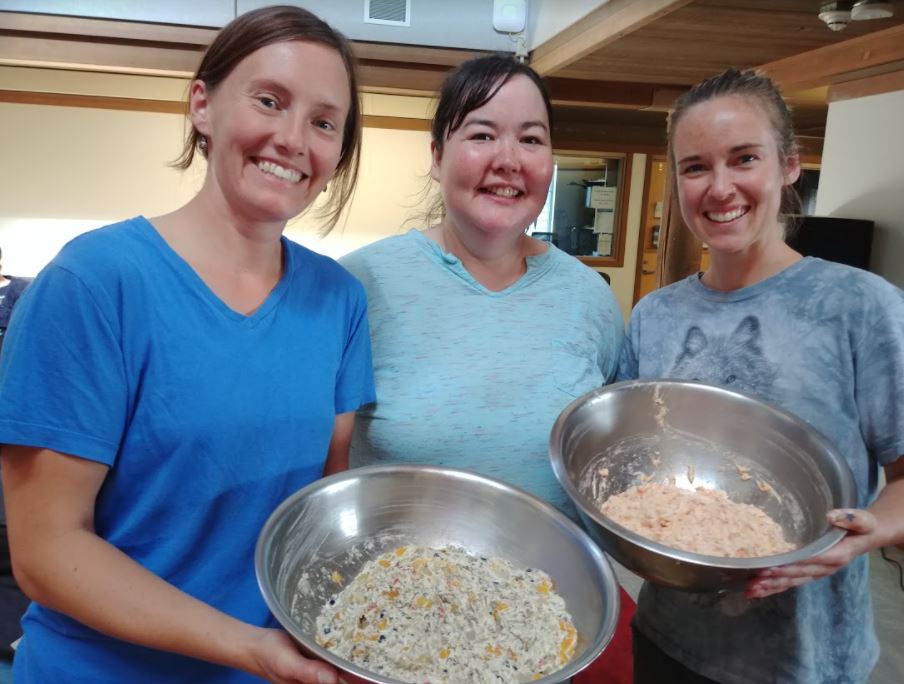
Alaska
An oft-repeated statistic from Alaska is that 95% of its food is imported, but this is oversimplified and only accounts for purchased goods (Meter & Goldenberg, 2014, p. 32). Wild foods are frequently harvested, foraged, gifted, and traded. For example, the replacement value for subsistence-harvested wild foods in 2012 was estimated at $4-$8 per pound, and a rural resident harvested an average of 295 pounds (Fall, 2014). In rural off-the-road-system Alaska where the price of a gallon of milk or gasoline is many times higher than in the lower 48 states, this informal economy is an important part of the food system. The main source of local food in Alaska is the combined subsistence and personal use gathering, worth about $900 million per year (Meter & Goldenberg, 2014). The food system in Alaska is vulnerable to both disruption of supply of, and access to, wild foods, including fish, wildlife, and wild plant resources (Fall & Kostick, 2018).
Despite their cultural and nutritional importance, we know little regarding how berry-producing plants may be affected by climate change (Hupp et al., 2015). If we do not establish a baseline, we cannot know what we are losing. Bioregions within Alaska are changing, and berry harvests are becoming unpredictable. Personal use harvesters are uniquely positioned to contribute from diverse perspectives across regions, income levels, and occupations (not just researchers from academia, and in both urban and rural Alaska).
Personal Use Harvest
During the COVID-19 pandemic, more people than ever are recreating on public lands and harvesting wild foods. Foraging by well-meaning but uninformed individuals has damaged wild food populations (Hay, 2020). This is particularly a concern in urban Alaska, which is where I do most of my harvesting and have had most of my plant experiences. The subject of food, peoples’ connection to food, and access or lack of access to healthy and culturally appropriate food is loaded with meaning wherever you live. I am still learning what that means and how I can help support Indigenous people in Alaska to continue to practice their cultural activities surrounding food. I am not Indigenous to the place where I live, and I harvest a number of wild plants every year for my own personal use. I feel healthier and more connected when I do, and I think many people in my community feel this way.
One research project in Fairbanks addressed this idea. Maher (2013) interviewed harvesters in the Fairbanks area regarding their motivations for harvesting NTFPs, specifically berries, mushrooms, and firewood, and compiled their responses into a clever infographic.
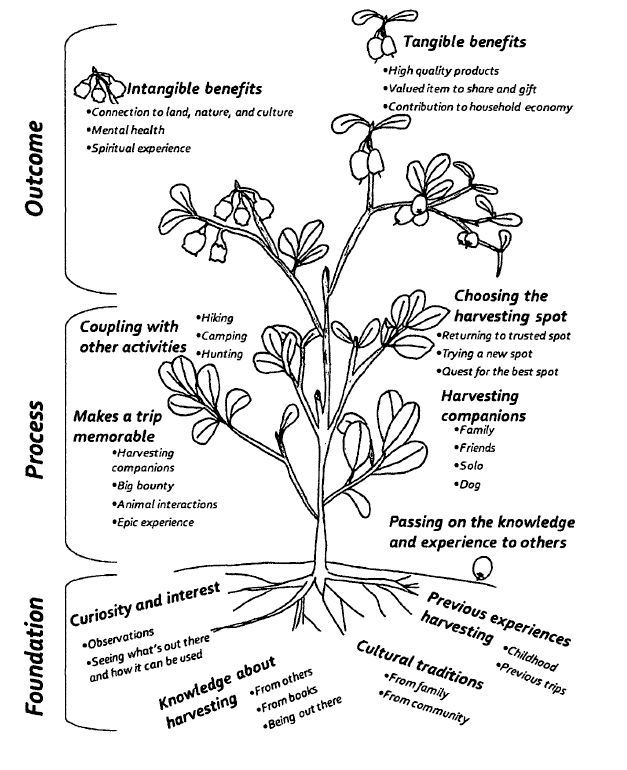
Existing studies of the management of NTFPs in Alaska are over 10 years old and focus on commercial harvesting (Kellogg et al., 2011; McLain & Jones, 2005; Pilz et al., 2006). The Alaska Ethnobotany Project was started in 2004 with the goal to evaluate which Alaska native plants were being commercially harvested, to what extent, and to act proactively before problems of access or scarcity occurred. “Hundreds, if not thousands, of people are saying ‘No way’ [to getting a permit] and as a result, there is very little information about where harvesting is happening and what is being taken” (Hunt, 2009). In 2008, they developed the Alaska Non-Timber Forest Products Manual for Commercial Harvest of Native Plants on State-Owned Lands. They contacted experts including Alaska Native Elders, harvesters, and subsistence users, university professors and students, and agency professionals. The document includes harvest protocols and quantity limits, like this example, “No more than ⅓ of the berries in the harvest area may be harvested. Always leave a portion of healthy viable fruit undisturbed” (Alaska Non-Timber Forest Products Harvest Manual, 2008, p. 10). The Alaska Ethnobotany Project is narrow in its scope of commercial harvest of NTFPs on State lands, but it was forward-thinking and can be a model for future projects.
The ratio of the human population to land area in Alaska is low, and NTFPs are plentiful. However, access is often restricted by limited road and trail access. This concentrates harvesters in certain areas. As foraging becomes increasingly popular, conflicts over resources and deterioration of what infrastructure may exist are inevitable. Like the Alaska Ethnobotany Project fifteen years ago, proactively addressing these needs and bringing participants together around solutions will set the stage for sustainable resource use.
Social Media
Some people are turning to social media to bridge the knowledge gap. These groups are undeniably creating connections and improving access to information and food within the community, though at times the accuracy of information is questionable. Group members are generous with their time, knowledge, and resources as seen in the three examples below. Alaska berry pickers has 20,600 members, Alaska Mushroom Madness has 3,600, and AK Edible and Medicinal Plants is a private group with 6,100 members (AK Edible and Medicinal Plants, n.d.; Alaska Berry Pickers, n.d.; Alaska Morel Harvest 2020 Alaska Mushroom Madness, n.d.). These groups could be targeted to answer survey questions, and posts can be used to identify needs within the community. I want to share a few posts that illustrate these points.

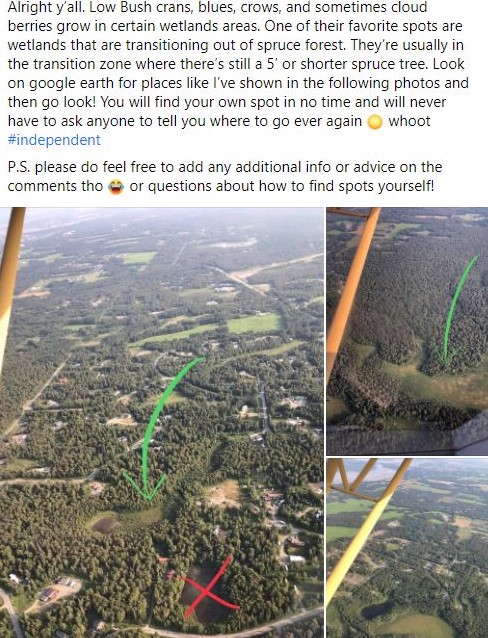

I surveyed the Spring 2021 Applied Ethnobotany class on 4/17/2021 as an initial step to see where current harvesters are getting their information. As ethnobotany students, we seem very consistent on how much harvesting we want to do and how unlikely we are to be on Facebook!
1. Have you harvested wild plants or fungi within the past year (April 2020 to present)?
Response: 100% yes
2. Did you harvest more or less in total quantity of plant material than the previous year?
Response: 60% same, 30% more, 10% less
3. Did you spend more or less time harvesting than the previous year?
Response: 66.7% same, 22.2% more, 11.1% less
4. Would you like to harvest more or less in the next year?
Response: 60% same, 40% more, 0% less
5. Do you belong to any Facebook groups about foraging (wild harvesting)?
Response: 70% no, 30% belong to 1-2 groups
6. Who taught you to forage/harvest/process wild plants as food, medicine, or other cultural uses? Choose as many as applicable.

Questions 7, 8, and 9 were an attempt to assess where people get their information, how convenient those sources are, and how accurate they are perceived to be using a scale of 1-5. Sources were Facebook, Instagram, iNaturalist, word-of-mouth, and field guides. The feedback I received was that other sources like Pinterest, Reddit, and Discord are useful and that I need to add an option for “I don’t know”. Due to the small sample size and many factors that could influence response, I’m not going to present each one here.
Some general trends for this group are:
- Less likely to use Facebook, Instagram, and iNaturalist. More likely to use word-of-mouth and field guides.
- The first three are less convenient. Word-of-mouth and field guides are more convenient.
- Facebook and Instagram are less accurate, iNaturalist and word-of-mouth are in the middle, and field guides are the most (but not completely) accurate.
Word Cloud
I also asked the Spring 2021 Applied Ethnobotany class to list all the plants they’ve gathered for food, medicine, or other cultural uses in the past year. This is the resulting word cloud, lightly edited for consistency (low bush cranberries –> lingonberries and also combining dandelion root with dandelion).
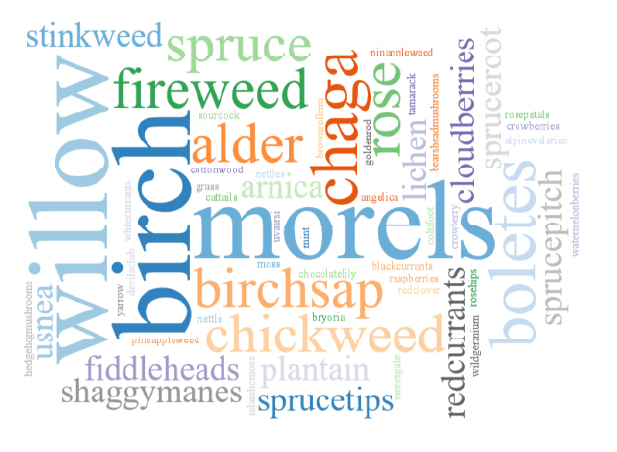
Conclusion
Creating a survey was an interesting experience and good practice, but my survey results were from such a small and specific sample group. The results are an interesting and fun way to end my last ethnobotany class, and it was good to get feedback before continuing on. I am interested in how knowledge about plants is shared, how that is changing as our world changes, and not only using social media.
“While wild foods cannot entirely bridge the existing supply and demand gaps, without them it would be much wider” (Bharucha & Pretty, 2010). We are at a pivotal point regarding climate change, increasing harvest pressure, and decreasing global biodiversity, so it is time to give attention and value to this resource. We can learn together how to manage NTFPs well, so that they will be available to sustain us physically, emotionally, and spiritually, for many generations to come. I am interested in creating personal use NTFP harvest materials that focus on creating a deep relationship with place and community. These materials should be culturally relevant and include land acknowledgments. The San Juan National Forest Service has a one-page publication titled Guidelines for Ethical and Sustainable Harvesting of Wild Plants (n.d) which ends with encouragement to “go back and monitor the effects of your harvest… become a steward and study the plants and how they respond”. The goal is to get more people involved, building relationships with plants and each other.
References:



